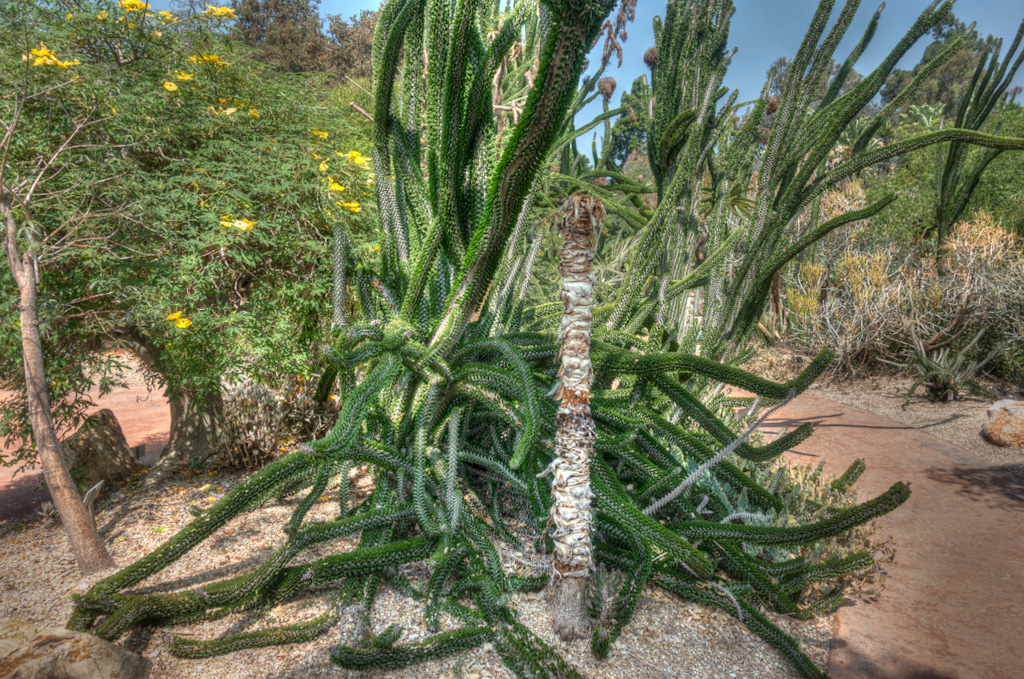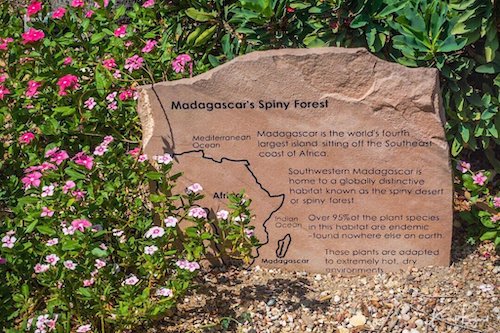
When I first learned of the Madagascar Spiny Forest garden at the Los Angeles Arboretum, I knew I had to visit. I have arbitrarily split the Madagascar Spiny Forest at the Los Angeles County Arboretum into two portions, roughly larger and smaller plants. This installation is a must for anyone planning to visit Madagascar or for those obsessed with succulents. This part is devoted to the famous Alluaudia and other trees of Madagascar. The Didiereaceae comprise 11 species divided into 4 genera, of which the largest is Alluaudia (six species). Alluaudia has been subdivided into the 2 sections Alluaudia and Androyella. In this way, Alluaudia procera has two sisters, Alluaudia ascendens and Alluaudia montagnacii. I have decided to do fairly major posts on this garden due to my recent visit to Madagascar. I hope this fills in the gaps on my plant coverage from there. In addition to this outdoor garden at the Arboretum (the only one on the West Coast), other collections of Madagascar’s unique plants that can be seen in the United States include: the Lin Lougheed Spiny Forest of Madagascar at Fairchild Tropical Botanic Garden, Coral Gables, Florida; a collection of spiny forest plants in Koko Crater Botanical Garden, a satellite site of the Honolulu Botanical Gardens, Oahu, Hawaii; an indoor collection at Atlanta Botanical Gardens, Atlanta, Georgia; and the indoor Spiny Desert of Madagascar at Cleveland Botanical Garden, Cleveland, Ohio.
Alluaudia
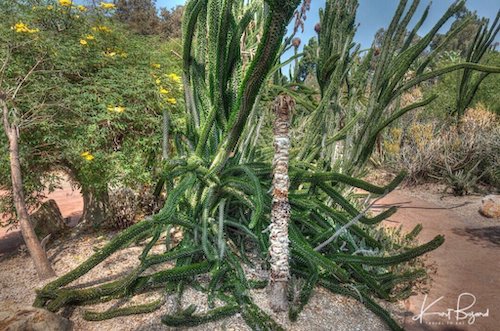
Alluaudia procera, or Madagascar ocotillo, is a deciduous succulent plant species of the family Didiereaceae. It is endemic to southern Madagascar. This plant is a spiny succulent shrub, with thick water-storing stems and leaves that are deciduous in the long dry season. Although strikingly similar in appearance, it is not closely related to the ocotillo, Fouquieria splendens of the Sonoran Deserts in North America. Young alluaudias form a tangle of stems that last for several years after which a strong central stem develops. The basal stems then die out leaving a tree-like stem that branches higher up on the main trunk. Researchers haven’t figured out where the Didiereaceae family originates from. However, the nearest relative of the Didiereaceae, Calyptrotheca somalensis, is endemic to East Africa, from which the island of Madagascar separated 100 million years ago. Thus, the Didiereaceae may have originated from the dispersal to Madagascar of a Calyptrotheca-like East African ancestor.
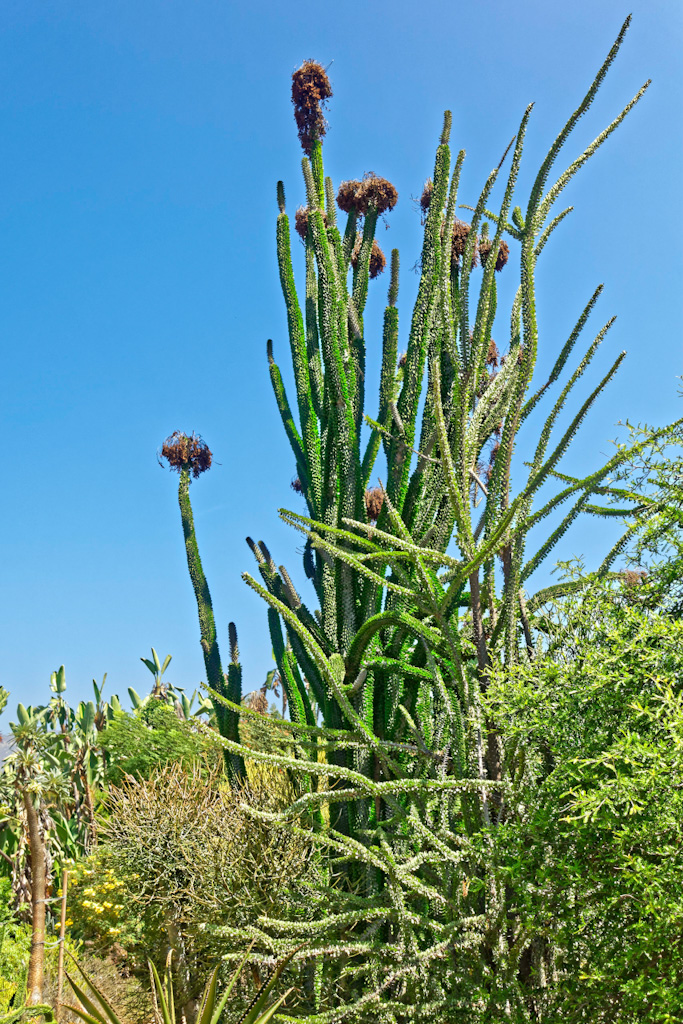
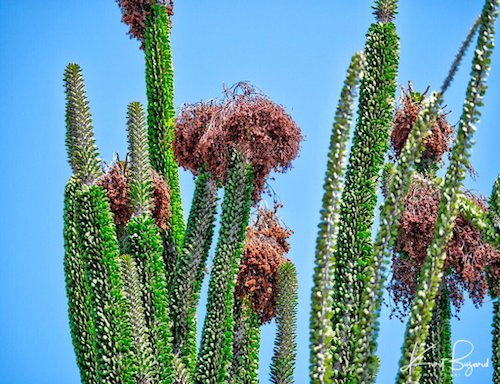
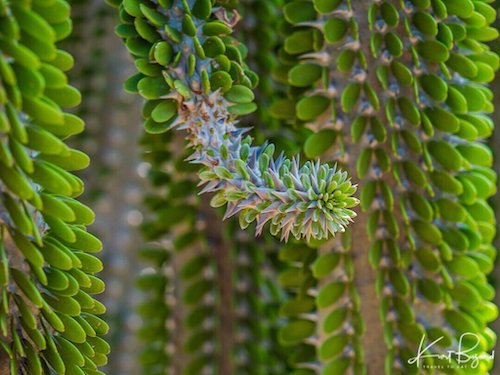
Alluaudia ascendens is a species of Alluaudia endemic to Madagascar. It can reach 15 m in height. Its local name is fantsiolotse. It grows in dry spiny shrub forest or dry deciduous thicket. These forests are stratified and Alluaudia ascendens occur in the upper canopy mixed with other species like: Adansonia za (Baobab tree), Operculicarya decaryi, Alluaudia procera, Commiphora aprevalii, and Tetrapterocarpon geayi.
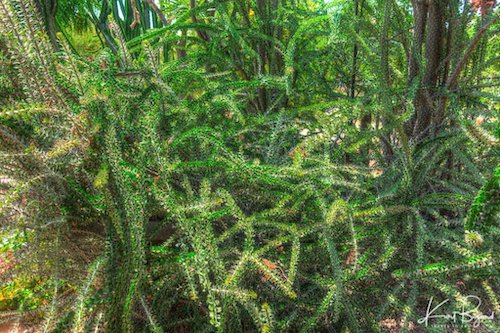
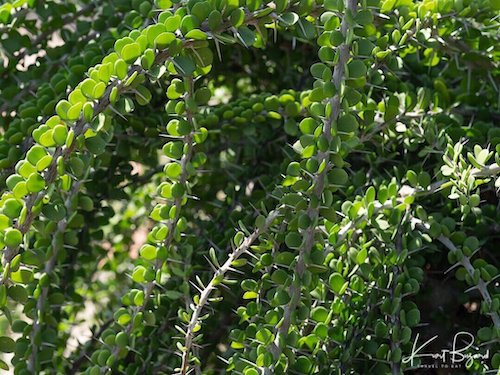
This is a slender and graceful representative of the Didiereaceae, a family of just 11 thorn-forest species native to Madagascar. Alluaudia humbertii has slender stems less than half the diameter of the more common A. procera but lined with similar slightly fleshy obovate vertically oriented bright green leaves. The leaves just described for these two species are produced secondarily, and repeatedly with recurring wet seasons. Short-lived primary leaves are produced only on new growth and are more slender, acute and oriented horizontally.
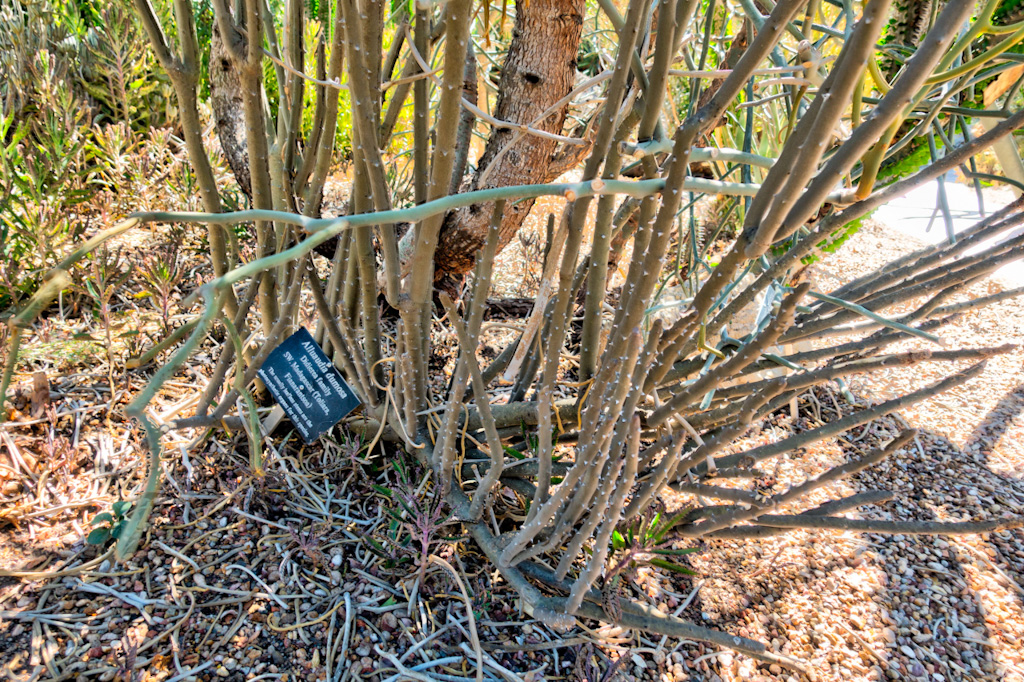
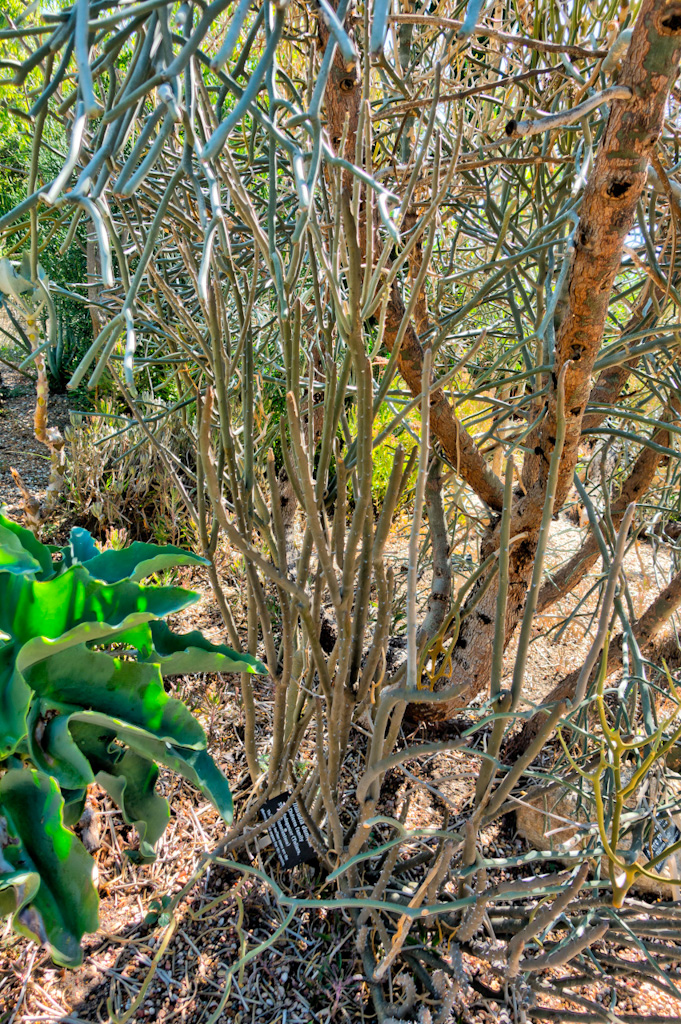
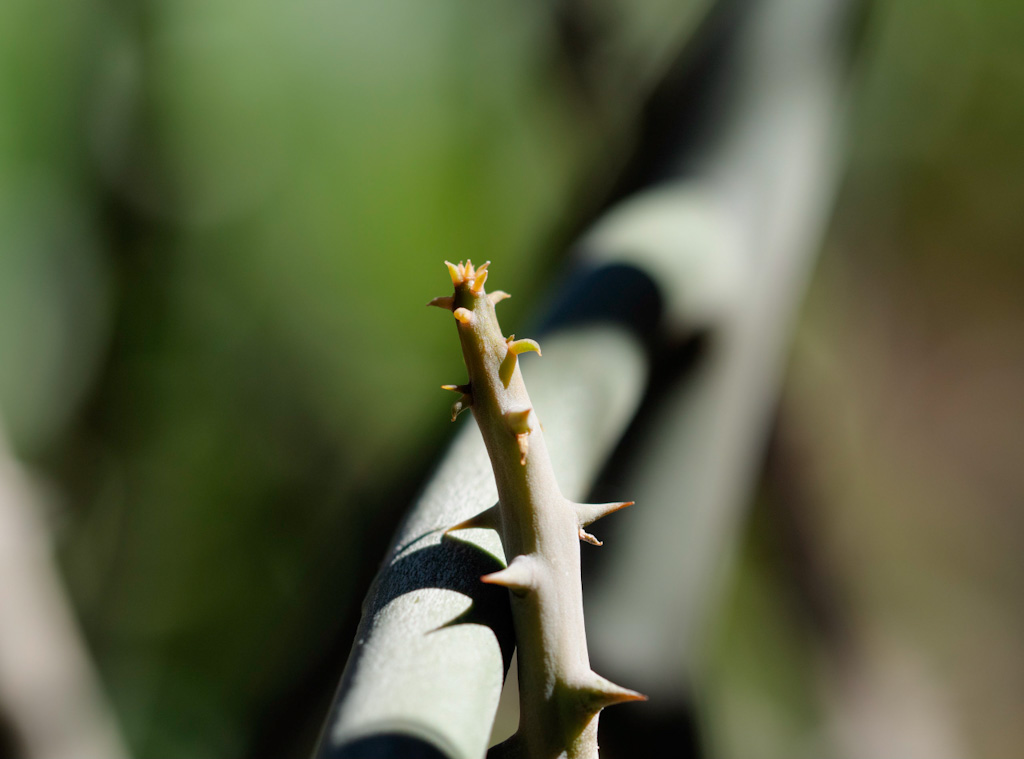
Alluaudia dumosa is a succulent shrub or small tree native to southwest Madagascar. It has grey-green thick succulent stems which have no adherent leaves and very few spines. It is a very slow grower. Alluaudia is a genus of flowering plants in the family Didiereaceae. There are six species, all endemic to Madagascar. The tree is harvested from the wild for local use as a medicine and source of wood. A decoction of the stems is used to treat toothache and is also used as a mouth disinfectant. Several flavonoids have been isolated from the plant – these may be responsible for the claimed antimicrobial activity.
Pachypodium
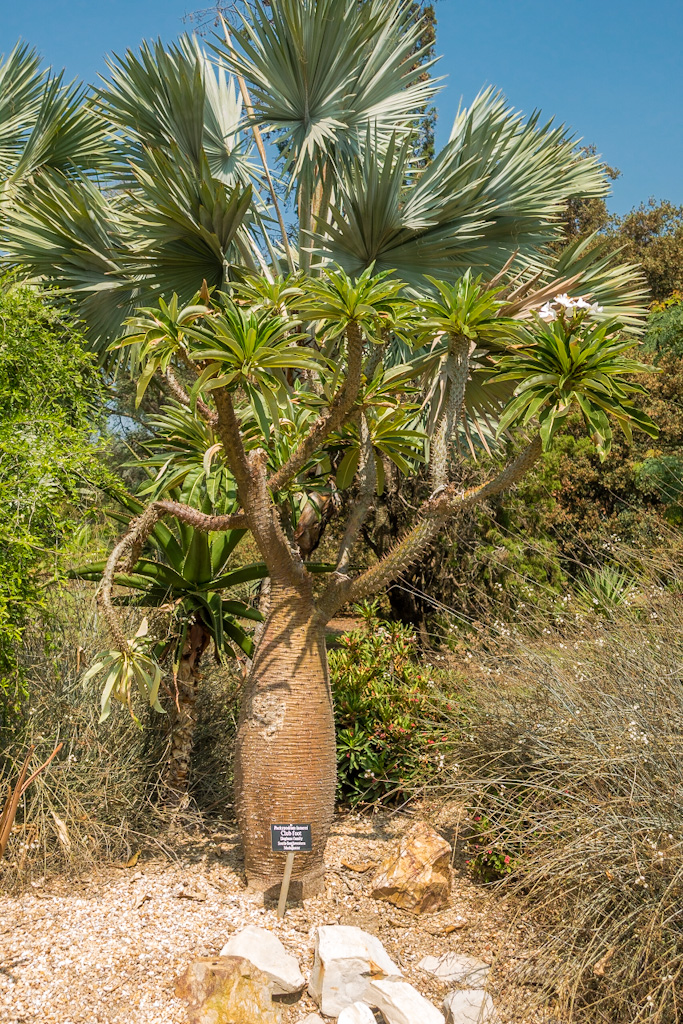
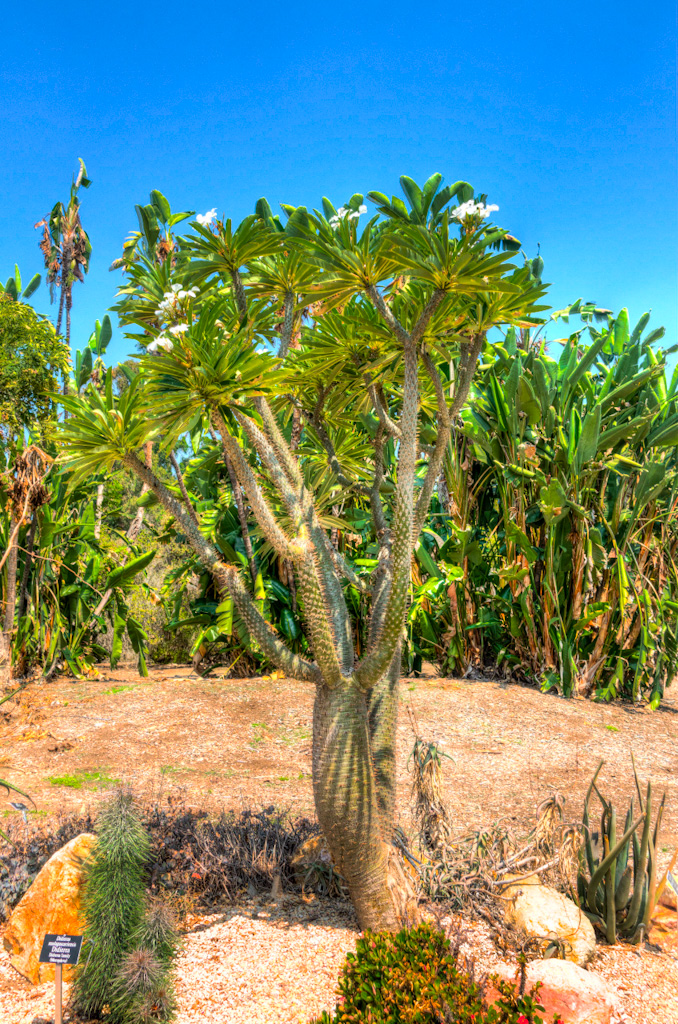

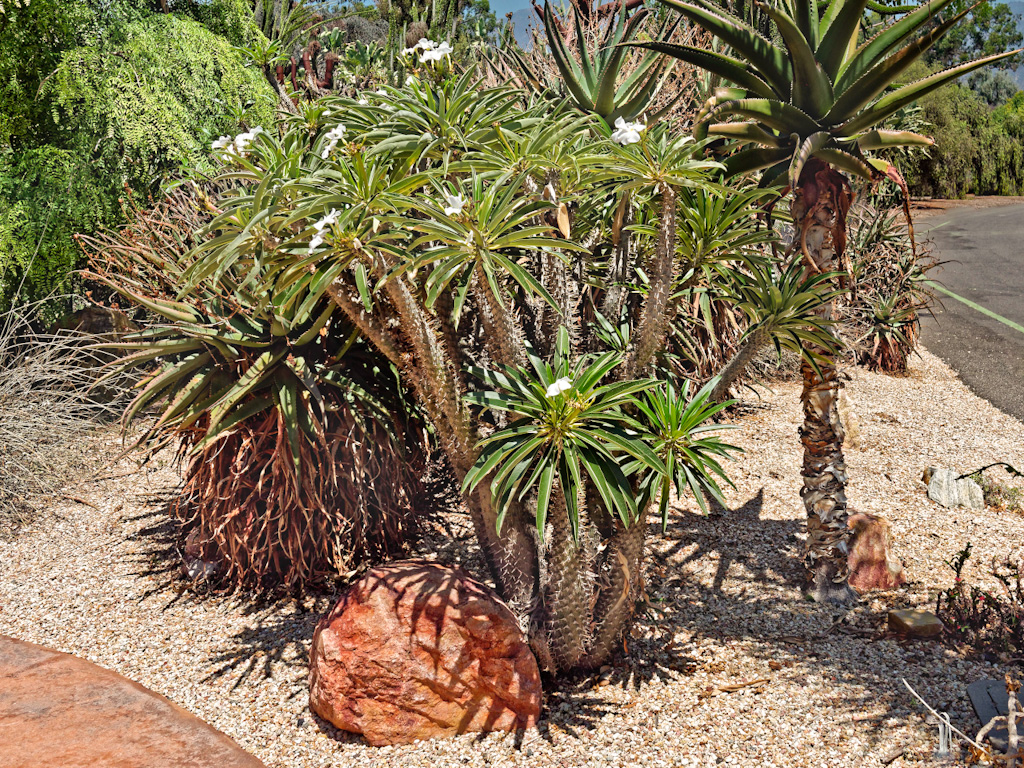
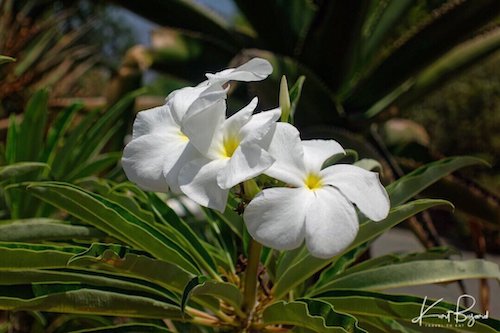
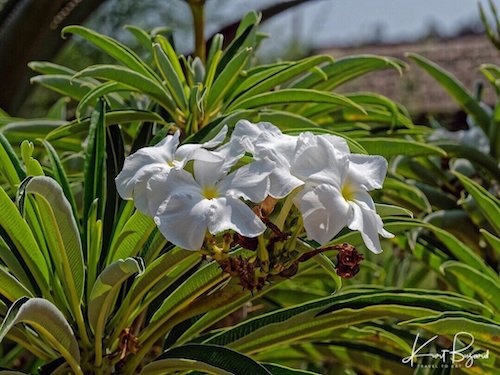
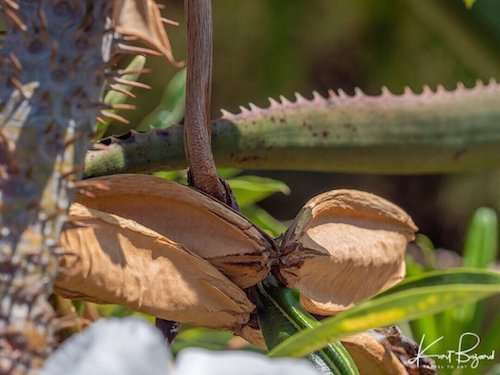
Pachypodium lamerei is a species of flowering plant in the dogbane family Apocynaceae. It is a stem succulent, photosynthesizing mainly through its trunk, and comes from the island of Madagascar, off the east coast of Africa. It has large thorns and leaves mostly just at the top of the plant, and large, fragrant flowers. The species has become one of the best known pachypodiums in cultivation, being relatively easy to propagate and grow. In cultivation it is often marketed as the Madagascar palm, despite its not being a palm at all. A variety called “Ramosum” has been described. It is distinguished mostly by a dwarf growth habit. Pachypodium lamerei has a tall, silvery-gray trunk covered with sharp 6.25 cm spines. Long, narrow leaves grow only at the top of the trunk, like a palm tree. It rarely branches. Plants grown outdoors will reach up to 6 m (20 ft), but when grown indoors it will slowly reach 1.2–1.8 m (3.9–5.9 ft) tall. Plants grown outdoors develop large, white, fragrant flowers at the top of the plant. They rarely flower indoors.

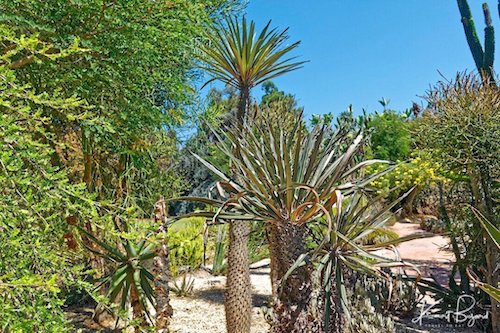
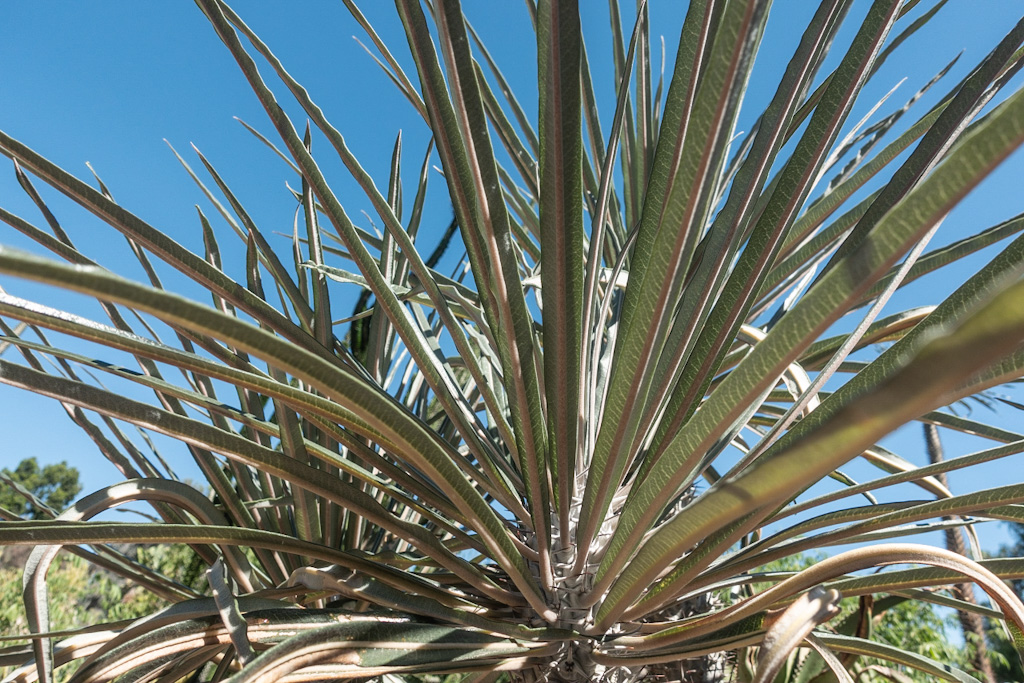
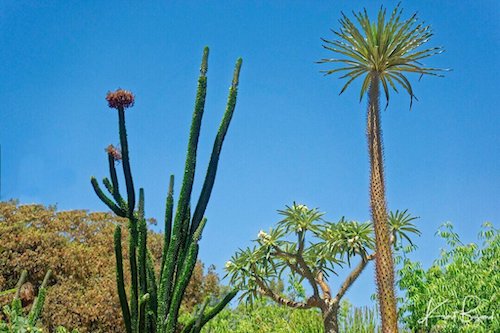
Pachypodium geayi is a species of Pachypodium that originated in Southwest Madagascar. It has a metallic grey pachycaule trunk and the leaves are thin and grey-green, with a bright pink mid-rib. The plant has white flowers. Pachypodium geayi is one of the largest of the Madagascar species. There are about 20 species of Pachypodium. The two most common Pachypodiums in cultivation (P. lamerei and geayi) account for at least 95% of the plants in gardens. They are very similar looking trees with white flowers and not easy to distinguish until they are mature.
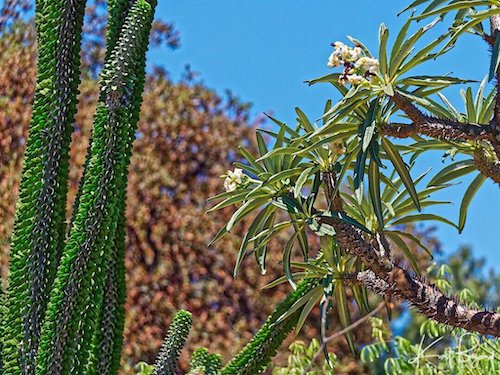
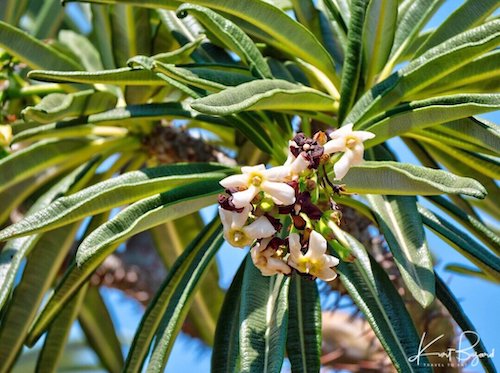
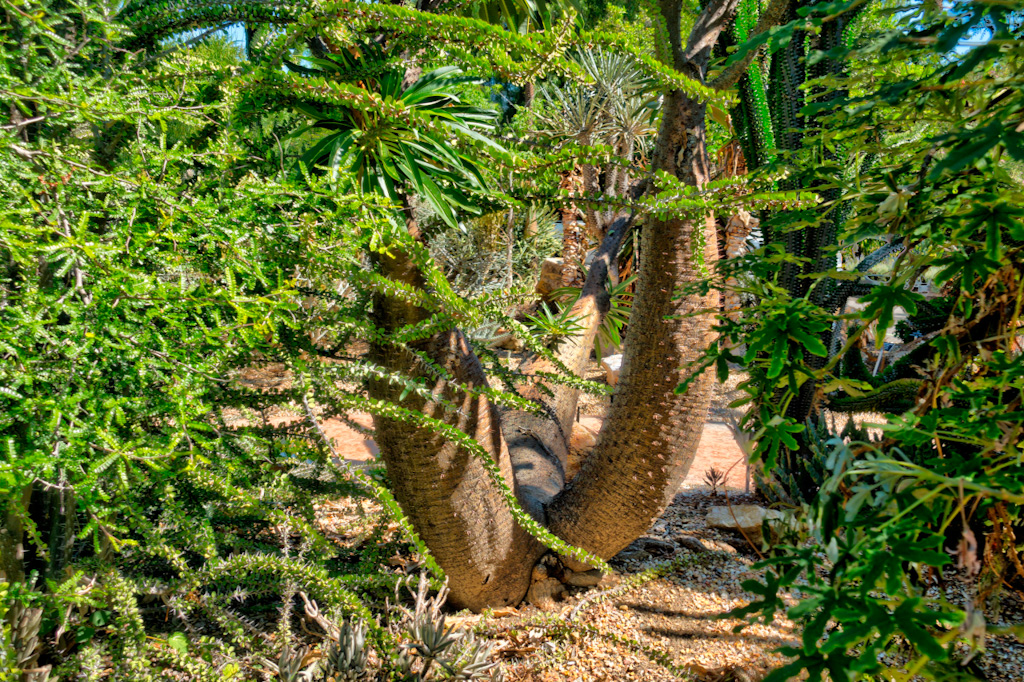
The Pachypodium lamerei var romosum is distinguished mostly by a dwarf growth habit with a more rounded trunk or caudex. It has also more rounded corolla lobes, gradually narrowed towards the base 4-5 cm long and has smooth leaves with no hairs. Additionally, the flowers seem to be different from the Pachypodium lamarei. This one is sort of boat shaped as you can see above.
Didierea
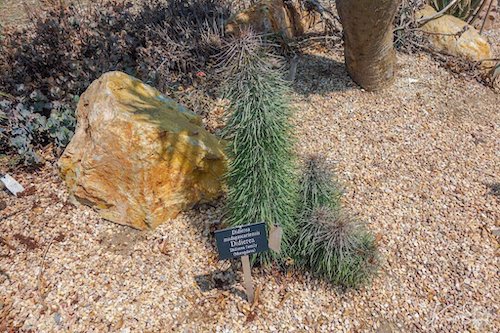
Didierea madagascariensis, commonly known as the octopus tree, is a species of Didiereaceae endemic to the spiny thickets of southwestern Madagascar. It was first described scientifically by the French botanist Henri Ernest Baillon in 1880. The type species of the genus Didierea, it is a densely spiny succulent and can grow up to 10 metres (33 ft) tall. This is a tiny specimen since it listed in CITES appendix II, which means that trade is restricted to protect natural populations.
Adansonia
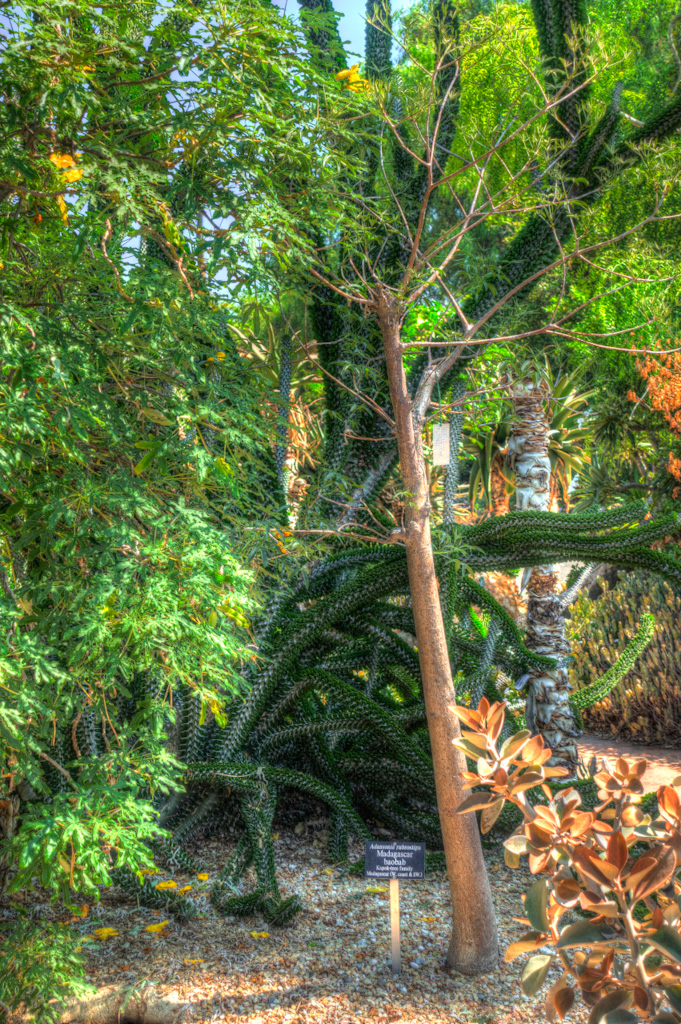
Adansonia rubrostipa, commonly known as fony baobab, is one of the nine species of baobab identified to date, and one of the six indigenous to Madagascar, within the family Malvaceae. This tree is endemic to western Madagascar and occurs in the Madagascar dry deciduous forests. This one will become much larger when mature. Baobabs reach heights of 5 to 30 m (16 to 98 ft) and have trunk diameters of 7 to 11 m (23 to 36 ft). The Malagasy species are important components of the Madagascar dry deciduous forests. Within that biome, Adansonia madagascariensis and A. rubrostipa occur specifically in the Anjajavy Forest, sometimes growing out of the tsingy limestone itself. A. digitata has been called “a defining icon of African bushland”. A specimen of A. digitata known as Grootboom was dated and found to be at least 1275 years old, making it one of the oldest known angiosperm trees. The Panke baobab in Zimbabwe was some 2,500 years old when it died in 2011, and two other trees — Dorslandboom in Namibia and Glencoe in South Africa — were estimated to be approximately 2,000 years old. Adansonia or Boab trees grow very tall and live a very long life.
Moringa
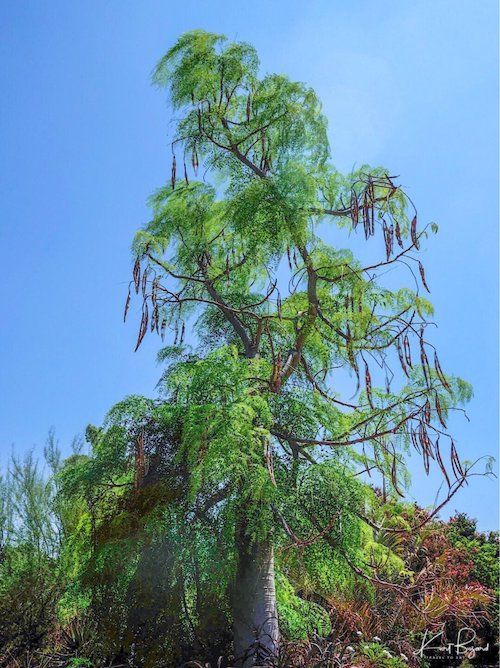
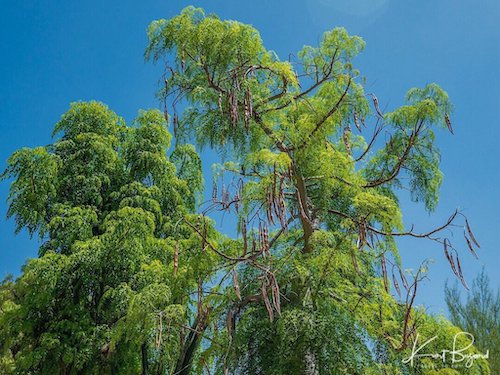
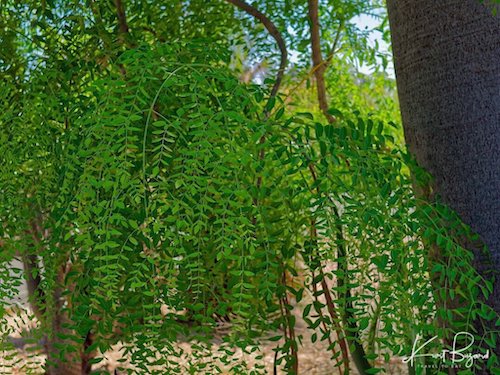
Moringa drouhardii, the bottle tree, is an endemic species of southwest Madagascar. It occurs in the Madagascar spiny thickets ecoregion, especially at the limestone cliffs to the east of Lake Tsimanampetsotsa, on the Mahafaly Plateau. The species is often planted in local villages and around traditional tombs. With its bloated bright white trunks, Moringa drouhardii is a conspicuous element of the southern Malagasy dry forest. It grows in scattered stands that can number hundreds of individuals, usually on limestone. Like other moringas in other parts of the world, Moringa drouhardii is used medicinally. The very strongly scented bark and wood are used for treatment of colds and coughs. Neither the seeds (rich in edible oil and proteins) nor the leaves (that can be eaten as green vegetables) are traditionally used in the Atsimo-Andrefana Region (southwestern Madagascar) despite their significant benefits.
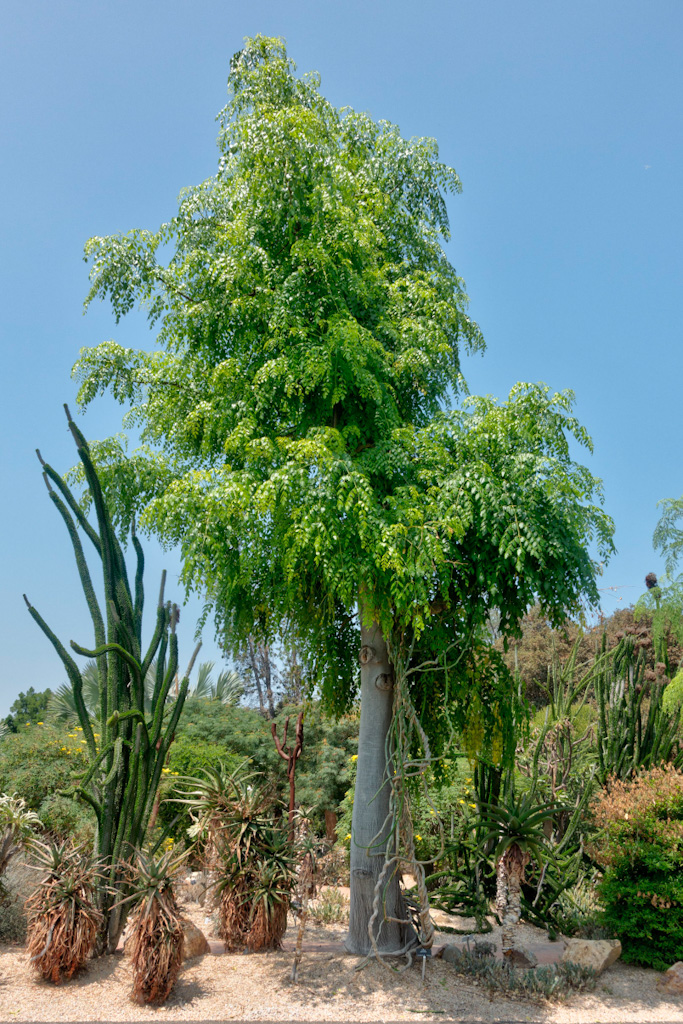
Moringa hildebrandtii is a beautiful tree with a massive, water-storing trunk that can grow to 65 feet (20 m) tall. This bloated trunk makes Moringa hildebrandtii strongly resemble the more well-known but unrelated boabab trees (Adansonia) that also occur in Madagascar. The pinnately compound leaves can be up to a meter long, and the leaf rachis and stem tip of young plants is often a distinctive deep red. The small whitish flowers are borne in large sprays. The first collection of Moringa hildebrandtii by western botanists was made in 1880, by Hildebrandt. He found it growing in the town of Trabonjy in northwestern Madagascar. Since then, other botanists have documented it growing in villages of the west coast, but no specimens have ever been collected from wild stands and it may in fact be extinct in the wild.
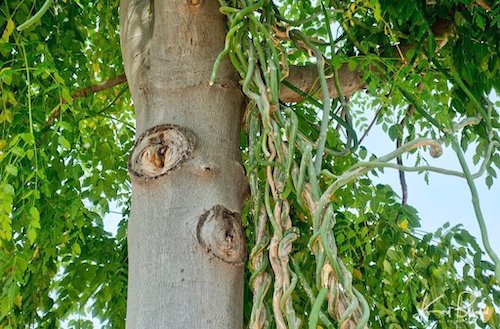
Climbing up the side of the Hildebrandt’s Moringa was a leafless vine that I saw often in Madagascar but was unable to identify it at the time. This stem-succulent Asclepiadaceae, endemic to southern Madagascar, produces what appears to be leafless stems that scramble through shrubs in habitat. Instead of having grand flowers, as the name suggests, this species produces many relatively small flowers along the stems. I am glad to finally know what it is called.
Operculicarya
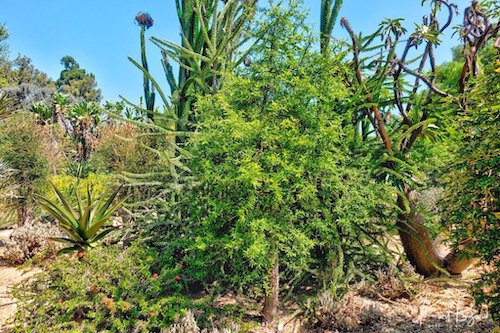
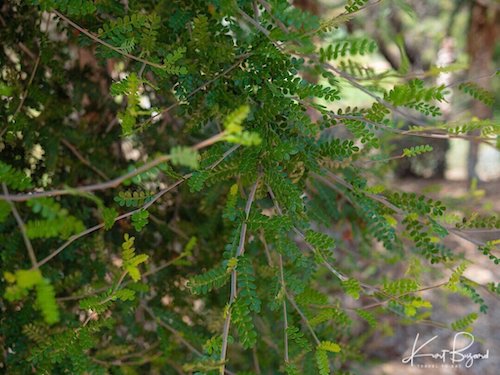
Operculicarya decaryi, known as Elephant Tree or Jabily, is a thick stemmed succulent plant species in the family Anacardiaceae, named after the botanical collector Raymond Decary. Operculicarya decaryi is endemic to southern and southwest Madagascar, where it grows in the provinces of Toliara and Fianarantsoa. It is a wide raging and relatively common species. It is also grown as a bonsai tree. It is drought tolerant and does well in full sun in most places. It cannot tolerate freezing conditions.
Delonix
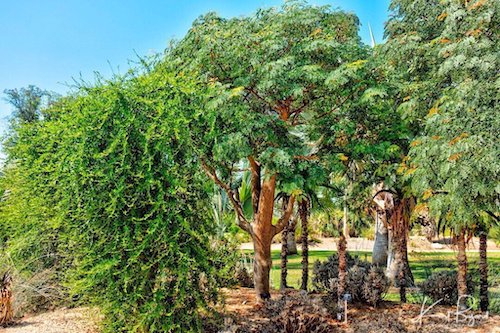
Delonix decaryi is a species of legume in the Fabaceae family. It is found only in Madagascar. Delonix decaryi, a white-flowered tree with a cigar-shaped trunk, is found in the dry spiny forest of Madagascar, and sometimes planted as a living fence. It is a member of the pea and bean family (Leguminosae). It is found in a narrow band along the coast from north of Toliara to Tolagnaro (Fort Dauphin).
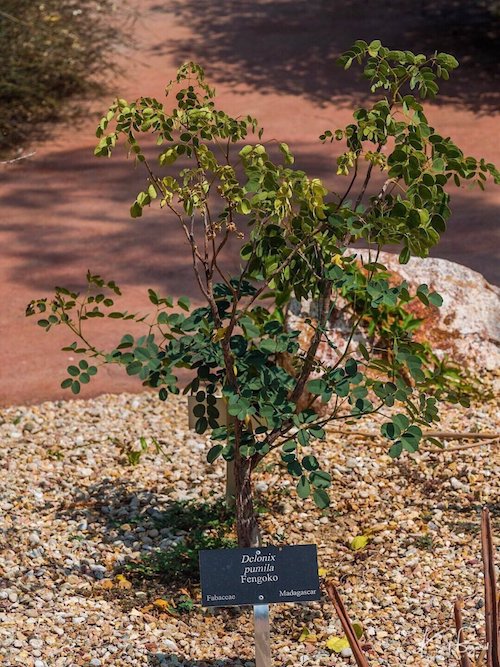
Delonix pumila otherwise known as Fengoko, is an Endangered legume found in the spiny forest of south-western Madagascar. The species is a “dwarf tree”, standing at less than 10 feet (3 m) tall, it is a deciduous tree with a distinctive swollen stem. Despite it’s small stature, the species has very large white flowers with dark stamens, which open at night and only last 24 hours. The dark central stamen help to attract moths, which are thought to pollinate the species as they collect nectar. It grows in the dry spiny forest near Toliara in south-western Madagascar, where the natural vegetation is under pressure from exploitation for firewood and charcoal production. Increased urbanization and grazing of livestock also lead to further degradation of the habitat quality and extent. Many of the species in the spiny forest, including D. pumila, are naturally slow-growing so the regeneration of the species is unable to keep up with increased rates of degradation.
Unicarina
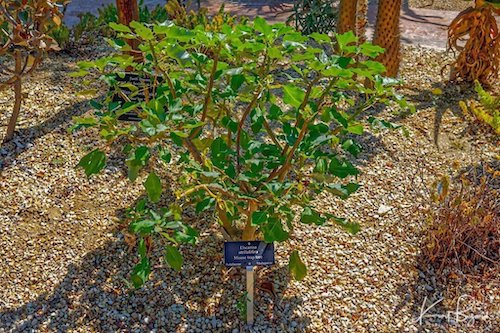
Uncarina is a genus of plant in the family Pedaliaceae found in Madagascar. Unicarina stellulifera is quite rare and forms a rather small tree with a thickened base. It is found on limestone in the Toliara area extending to Lake Tsimanampetsotsa and as far north as Morandava. The leaves are less deeply divided than Uncarina decaryi. The flowers are rose-pink with unusual spiky fruit. (Werner Rauh)

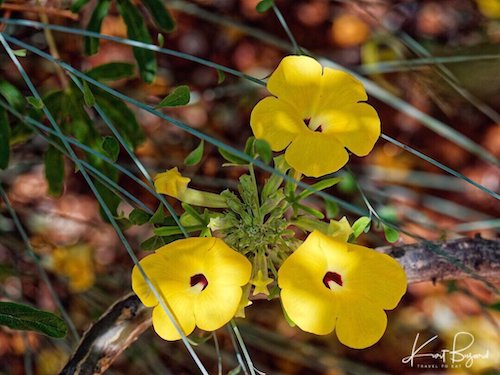
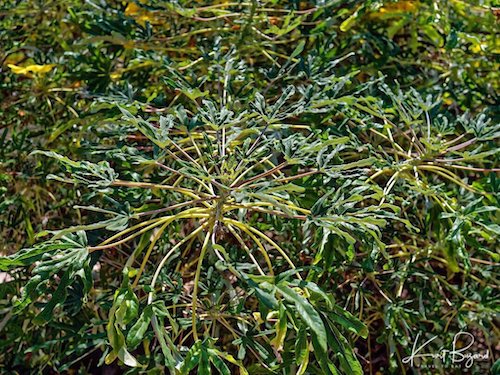
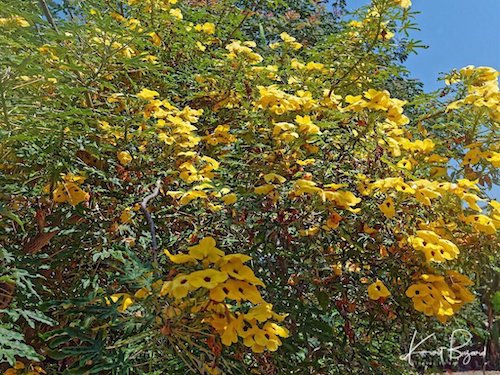
Uncarina decaryi is a large, tropical shrub or small, caudiciform tree up to 25 feet (7.5 m) tall (usually up to 10 feet / 3 m) and trunk up to 12 inches (30 cm) in diameter, covered with grayish-ochre bark. The green leaves are triangular, finely hairy, up to 2.4 inches (6 cm) long and deciduous during the winter resting season. The flowers are bright yellow with dark red to black centers.
Cynanchum
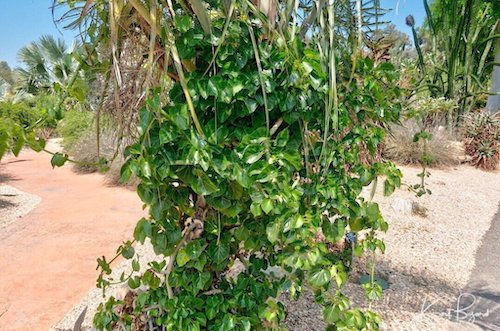
An unusual member of this genus of milkweeds, it is named for its exceptionally succulent stems. It could just as well have been called Cynanchum “macrophyllum”, as it also has unusually well-developed leaves for the genus. These are cordate (heart-shaped) and two to three inches long. When rubbed, they emit a curious musty aroma reminiscent of mouse. This smell is the same produced by the inflorescences of Peperomia graveolens, which in the latter may serve to attract fly pollinators. What purpose it serves the Cynanchum is unknown, except perhaps its rankness deters herbivores. It is native to Madagascar where it is found as a climbing vine in the Didierea forests (Spiny Forests) of southern Madagascar.
Gugal
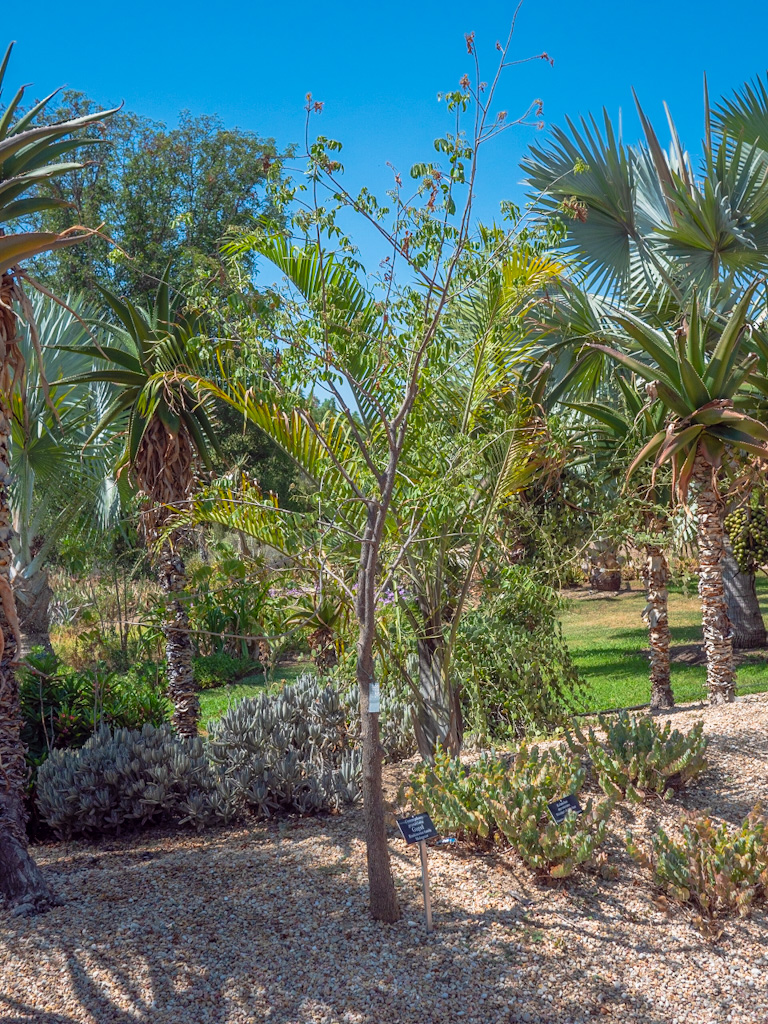
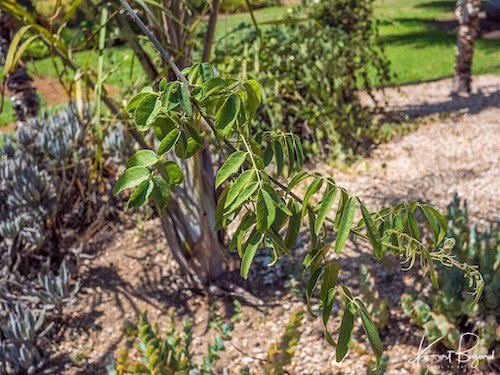
The genus of the myrrhs, Commiphora, is the most species-rich genus of flowering plants in the frankincense and myrrh family, Burseraceae. The genus contains approximately 190 species of shrubs and trees, which are distributed throughout the subtropical regions of Africa, the western Indian Ocean islands including Madagascar, the Arabian Peninsula, India, and Vietnam. The genus is drought-tolerant and common throughout the xerophytic scrub, seasonally dry tropical forests, and woodlands of these regions. Commiphora grandiflora is found in the Kirindy Mitea National Park on the coast of the Mozambique Channel, in south-west Madagascar. Gugal or Indian Bdellium-tree, Guggul, Gugul, or Mukul Myrrh Tree most often refers to Commiphora wightii, found from northern Africa to central Asia, but is most common in northern India. It prefers arid and semi-arid climates and is tolerant of poor soil. The resin of Commiphora wightii, known as gum guggulu, has a fragrance similar to that of myrrh and is commonly used in incense and perfumes. It is the same product that was known in Hebrew, ancient Greek and Latin sources as bdellium.
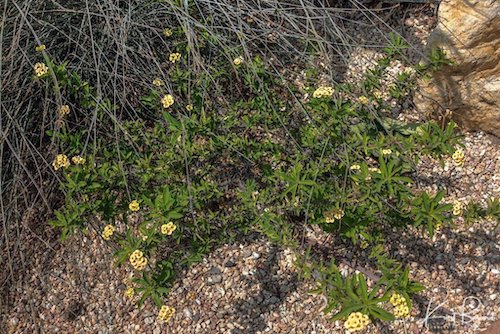
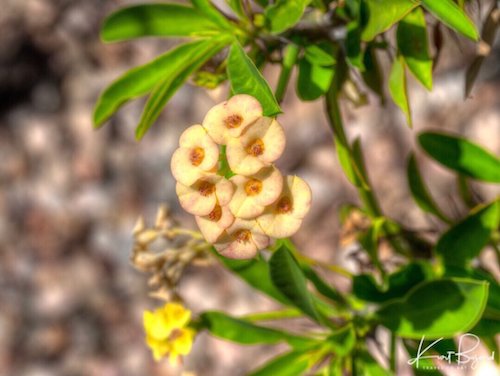
Euphorbia milii, the crown of thorns, Christ plant, or Christ thorn, called Corona de Cristo in Latin America (coroa-de-cristo in Brazil), is a species of flowering plant in the spurge family Euphorbiaciae, native to Madagascar. The species name commemorates Baron Milius, once Governor of Réunion, who introduced the species to France in 1821.
Well this is a pretty spectacular garden and we are only half finished. I hoped you enjoyed this post, please leave a comment.
[mappress mapid=”240″]

